
We are celebrating 15 years — and counting — of stories that are deeply researched and deeply felt, that build a historical record of what the city has been.
We are celebrating 15 years — and counting — of stories that are deeply researched and deeply felt, that build a historical record of what the city has been.
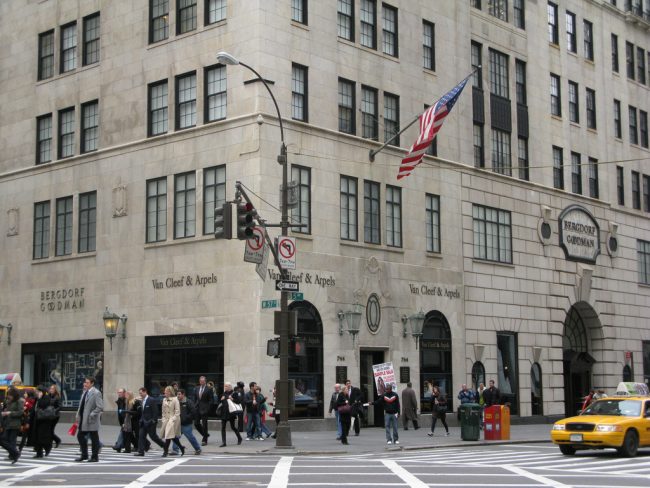
The Bergdorf Goodman building on 5th Avenue | Photo by Salon NYC
The Landmarks Preservation Commission (LPC) voted to remove scores of New York City buildings from its control on Tuesday, freeing owners to begin demolition and renovation within the limits of the zoning code. In 30 cases, including the original Bergdorf Goodman store, Alvar Aalto’s Edgar J. Kaufmann Conference Center at the United Nations, the gatehouse of Green-Wood Cemetery, and the Pepsi-Cola Sign in Long Island City, the Commission opted to prioritize landmark designation. Those properties will be subject to hearings and a vote later in the year.
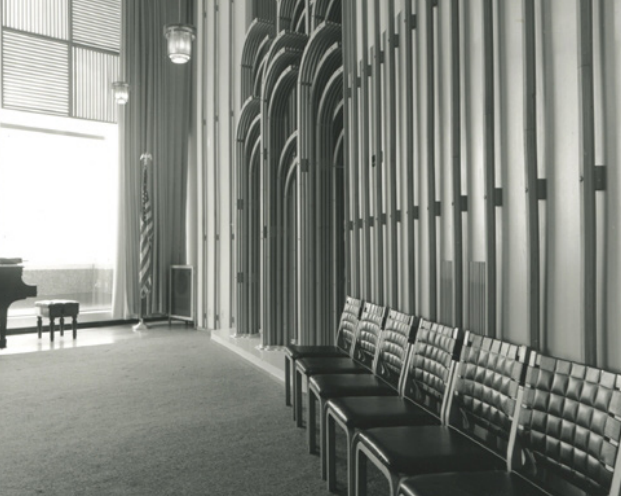
Alvar Aalto’s interiors at the United Nations are the Finnish architect’s only work in New York. | Photo via LPC
Among some preservationists, the decision to remove two-thirds of the backlogged properties from the “Calendar,” some of which had been in Landmark Limbo for fifty years, was seen as a political concession. The City Council, under pressure from property owners and developers, has discussed legislation to trim the LPC’s authority, and Meenakshi Srinivasan, the Commission’s chairwoman, had earlier moved to clear the entire docket.
Of the sites Ben Pardee profiled in our Landmarks Limbo series, Williamsburg’s Broadway Building — one of the few cast-iron structures in the outer boroughs — and the handsome Excelsior Power Company Building in Lower Manhattan made the cut. Other properties on the path to preservation include Stanford White’s IRT Powerhouse on 59th Street and 12th Avenue in Manhattan, Staten Island’s Vanderbilt Mausoleum and Prince’s Bay Lighthouse, and the Edward Hopper-esque 65 Schofield Street house on the Bronx’s City Island. The LPC also opted to preserve ten of the sixteen churches awaiting designation, including the United Palace in Washington Heights, which now houses an evangelical congregation.
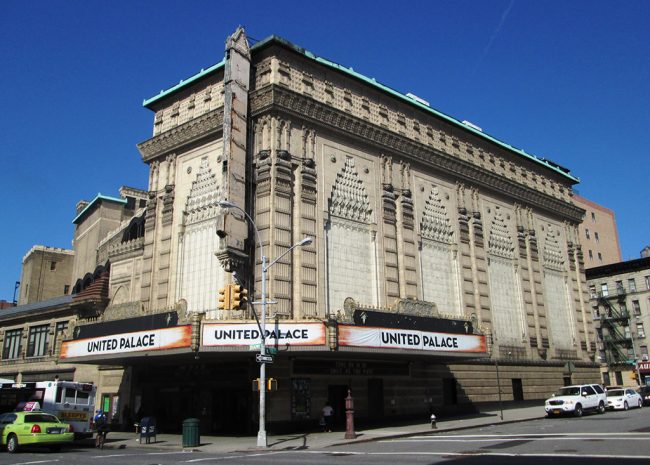
The Loew’s 175th Street Theater is slated for landmark status. | Photo by Beyond My Ken.
Notable buildings free for redevelopment include the Old Calvary Cemetery Gatehouse in Queens, the Coney Island Pumping Station in Brooklyn, the Fieldston Delafield Estate Building in the Bronx, and a number of Manhattan theaters including the Victory Theater and the Lyric Theater. The LPC also voted “no action” on expansions to the Jackson Heights and Douglaston historic districts in Queens.
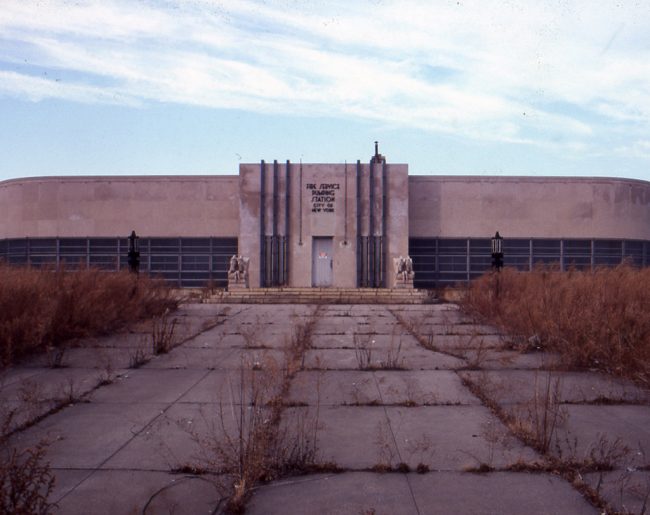
Irwin S. Chanin’s fire service pumping station on Coney Island, with the original Pegasus statues guarding the entrance (1980) | Photo via LPC
Some “no action” sites, such as Harlem’s D.G. Yuengling Brewing Co. Complex, a cluster of six red-brick buildings that date from the late 19th and early 20th centuries, are likely to be renovated soon, before preservationists can mount another attempt to landmark them. (Unless a site has been rejected for lack of merit, it is eligible to be considered again.) The former brewery district, which is owned by Janus Property Company, is now a lucrative development site. Neighborhood advocates in favor of landmark designation had argued that the area’s post-industrial charm made it a strong candidate for adaptive reuse in its current form.
A handful of properties had changed so significantly since their appearance on the calendar that the LPC deemed they had lost their historical importance. Those include a handful of properties on Staten Island that have since been demolished entirely. The President Chester A. Arthur House in Murray Hill was not removed from consideration for lack of merit, but the parlor floor, where Arthur lived and was sworn in after James Garfield’s assassination, has since become an Indian grocery store.
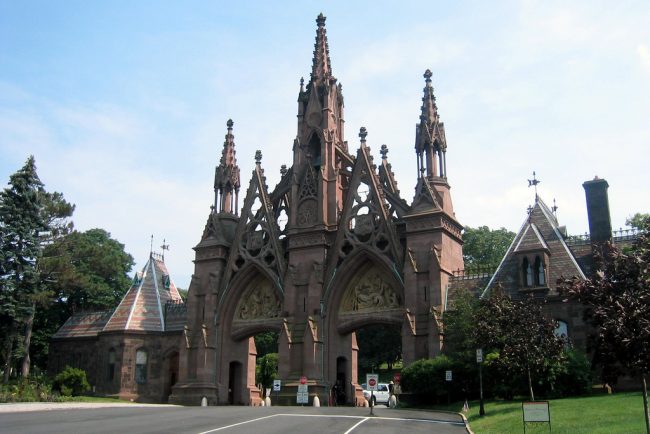
The soaring 1861 gate of Greenwood Cemetery | Photo by Wally Gobetz
The Pepsi-Cola Sign on the Hunter’s Point waterfront would be the city’s first landmarked sign. In an odd twist of landmark law, LPC can landmark the sign — but can’t control the lettering content.
Here’s the full path to preservation list:
BRONX
Immaculate Conception, Church of the Blessed Virgin Mary, Convent and Priests’ Residence, 375-395 East 150th Street
65 Schofield Street House, 65 Schofield Street
BROOKLYN
183-195 Broadway Building, 183-195 Broadway
Williamsburg Trust Co. Building (Ukranian Church in Exile Holy Trinity Cathedral), 177 South 5th Street
St. Augustine’s Roman Catholic Church and Rectory, 130 Sixth Avenue
Greenwood Cemetery, Greenwood Cemetery
Lady Moody-Van Sicklen House, 27 Gravesend Neck Road
St. Barbara’s Roman Catholic Church, 138 Bleecker Street
QUEENS
Bowne Street Community Church, 38-01 Bowne Street
Lydia Ann Bell and William Ahles House, 39-26 213th Street
Pepsi-Cola Sign, 4600 Fifth Street
STATEN ISLAND
92 Harrison Street House, 92 Harrison Street
George W. Curtis House, 234 Bard Avenue
St. John’s Protestant Episcopal Rectory, 1331 Bay Street
Vanderbilt Mausoleum and Cemetery, Moravian Cemetery, Richmond Road and Altamont St.
Brougham Cottage, 4746 Amboy Road
Prince’s Bay Lighthouse and Keeper’s House, Hylan Boulevard
Lakeman House, 2286 Richmond Road
MANHATTAN
315 Broadway Building, 315 Broadway
57 Sullivan Street House, 57 Sullivan Street
Interborough Rapid Transit Powerhouse, now ConEd Powerhouse, 850 12th Avenue
Bergdorf Goodman, 754 Fifth Avenue
Edgar J. Kaufman Conference Rooms, Lecture Hall & Elevator Lobby, 809 United Nations Plaza
St. Michael’s Episcopal Church, Parish House & Rectory, 227 West 99th Street
412 East 85th Street House, 412 East 85th Street
St. Joseph’s Church, 401-403 West 125th Street
Young Men’s Christian Association (YMCA) Building, Harlem Branch, 181 West 135th Street
St. Paul’s Church and School, 121 East 117th Street
Loew’s 175th Street Theater, 4140 Broadway
Excelsior Power Company Building, 33-43 Gold Street
Graphic by Allison Henry.
Read more of Henry Grabar’s work here.
The views expressed here are those of the authors only and do not reflect the position of The Architectural League of New York.